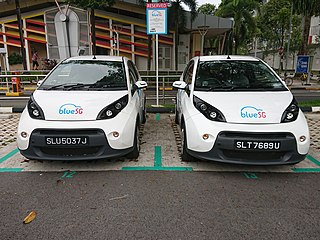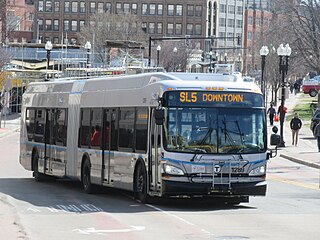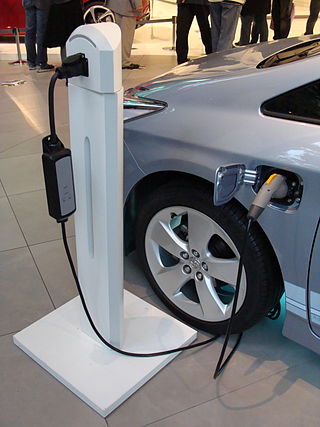
A hybrid vehicle is one that uses two or more distinct types of power, such as submarines that use diesel when surfaced and batteries when submerged. Other means to store energy include pressurized fluid in hydraulic hybrids.

Practical electric vehicles appeared during the 1890s. An electric vehicle held the vehicular land speed record until around 1900. In the 20th century, the high cost, low top speed, and short-range of battery electric vehicles, compared to internal combustion engine vehicles, led to a worldwide decline in their use as private motor vehicles. Electric vehicles have continued to be used for loading and freight equipment and for public transport – especially rail vehicles.

Carsharing or car sharing or car clubs (UK) is a model of car rental where people rent cars for short periods of time, often by the hour. It differs from traditional car rental in that the owners of the cars are often private individuals themselves, and the carsharing facilitator is generally distinct from the car owner. Carsharing is part of a larger trend of shared mobility.
Flexcar is a vehicle subscription company based in Boston, MA. They offer weekly subscriptions to a variety of cars with touchless pickup from locations in Boston, Nashville, and Atlanta. Flexcars include maintenance and insurance and customers can cancel their subscription anytime without penalty.

Zipcar is an American car-sharing company and a subsidiary of Avis Budget Group. Zipcar provides vehicle reservations to its members, billable by the minute, hour or day; members may have to pay a monthly or annual membership fee in addition to car reservations charges. Gas, maintenance, insurance options, and a dedicated parking spot are included. Zipcar was founded in 2000 by Antje Danielson and Robin Chase.

BYD Auto Co., Ltd. is the automotive subsidiary of the publicly listed Chinese multinational manufacturer BYD Company, headquartered in Xi'an, Shaanxi Province, China. It was founded in January 2003, following BYD Company's acquisition of Qinchuan Automobile Company in 2002. The company produces passenger cars, buses, trucks, electric bicycles, forklifts, and rechargeable batteries. The current model range of automobiles includes battery electric vehicles (BEVs) and plug-in hybrid electric vehicles (PHEVs), and the company also produced petrol engine vehicles up until March 2022.

A plug-in hybrid electric vehicle (PHEV) is a hybrid electric vehicle whose battery pack can be recharged by plugging a charging cable into an external electric power source, in addition to internally by its on-board internal combustion engine-powered generator. Most PHEVs are passenger cars, but there are also PHEV versions of commercial vehicles and vans, utility trucks, buses, trains, motorcycles, mopeds, and even military vehicles.
PhillyCarShare was a non-profit car-sharing organization in Philadelphia, Pennsylvania established in 2002. The service was acquired by Enterprise in 2011, and was renamed Enterprise CarShare in 2014.

A hybrid electric vehicle (HEV) is a type of hybrid vehicle that combines a conventional internal combustion engine (ICE) system with an electric propulsion system. The presence of the electric powertrain is intended to achieve either better fuel economy than a conventional vehicle or better performance. There is a variety of HEV types and the degree to which each function as an electric vehicle (EV) also varies. The most common form of HEV is the hybrid electric car, although hybrid electric trucks, buses, boats and aircraft also exist.

RechargeIT is one of five initiatives within Google.org, the charitable arm of Google, created with the aim to reduce CO2 emissions, cut oil use, and stabilize the electrical grid by accelerating the adoption of plug-in electric vehicles.

A battery electric vehicle (BEV), pure electric vehicle, only-electric vehicle, fully electric vehicle or all-electric vehicle is a type of electric vehicle (EV) that exclusively uses chemical energy stored in rechargeable battery packs, with no secondary source of propulsion. BEVs use electric motors and motor controllers instead of internal combustion engines (ICEs) for propulsion. They derive all power from battery packs and thus have no internal combustion engine, fuel cell, or fuel tank. BEVs include – but are not limited to – motorcycles, bicycles, scooters, skateboards, railcars, watercraft, forklifts, buses, trucks, and cars.

A plug-in electric vehicle (PEV) is any road vehicle that can utilize an external source of electricity to store electrical energy within its onboard rechargeable battery packs, to power an electric motor and help propelling the wheels. PEV is a subset of electric vehicles, and includes all-electric/battery electric vehicles (BEVs) and plug-in hybrid electric vehicles (PHEVs). Sales of the first series production plug-in electric vehicles began in December 2008 with the introduction of the plug-in hybrid BYD F3DM, and then with the all-electric Mitsubishi i-MiEV in July 2009, but global retail sales only gained traction after the introduction of the mass production all-electric Nissan Leaf and the plug-in hybrid Chevrolet Volt in December 2010.

The adoption of plug-in electric vehicles in the United States is supported by the American federal government, and several states and local governments. As of December 2021, cumulative sales in the U.S. totaled 2.32 million highway legal plug-in electric cars since 2010, led by all-electric cars. The American stock represented 20% of the global plug-in car fleet in use by the end of 2019, and the U.S. had the world's third largest stock of plug-in passenger cars after China (47%) and Europe (25%).

Electric car use by country varies worldwide, as the adoption of plug-in electric vehicles is affected by consumer demand, market prices, availability of charging infrastructure, and government policies, such as purchase incentives and long term regulatory signals.

Government incentives for plug-in electric vehicles have been established around the world to support policy-driven adoption of plug-in electric vehicles. These incentives mainly take the form of purchase rebates, tax exemptions and tax credits, and additional perks that range from access to bus lanes to waivers on fees. The amount of the financial incentives may depend on vehicle battery size or all-electric range. Often hybrid electric vehicles are included. Some countries extend the benefits to fuel cell vehicles, and electric vehicle conversions.

The Norwegian fleet of plug-in electric vehicles is the largest per capita in the world. In December 2016, Norway became the first country where five in every 100 passenger cars on the road were plug-in; attained 10% in October 2018, and reached 25% in September 2022.

The adoption of plug-in electric vehicles in the Netherlands is actively supported by the Dutch government through the exemption of the registration fee and road taxes. These purchase incentives have been adjusted over time. Considering the potential of plug-in electric vehicles in the country due to its relative small size and geography, the Dutch government set a target of 15,000 to 20,000 electric vehicles with three or more wheels on the roads in 2015; 200,000 vehicles in 2020; and 1 million vehicles in 2025. The first two targets were achieved two years earlier than planned.

The adoption of plug-in electric vehicles in the United Kingdom is actively supported by the British government through the plug-in car and van grants schemes and other incentives. About 745,000 light-duty plug-in electric vehicles had been registered in the UK up until December 2021, consisting of 395,000 all-electric vehicles and 350,000 plug-in hybrids. Until 2019, the UK had the second largest European stock of light-duty plug-in vehicles in use after Norway.

The stock of plug-in electric vehicles in California is the largest in the United States, and as of December 2021, cumulative plug-in car registrations in the state since 2010 totaled 1.072 million units. California is the largest U.S. car market with about 10% of all new car sales in the country, but has accounted for almost half of all plug-in cars sold in the American market since 2011. Since November 2016 and until 2020, China was the only country market that exceeded California in terms of cumulative plug-in electric car sales.

The adoption of plug-in electric vehicles in Europe is actively supported by the European Union and several national, provincial, and local governments in Europe. A variety of policies have been established to provide direct financial support to consumers and manufacturers; non-monetary incentives; subsidies for the deployment of charging infrastructure; and long term regulations with specific targets. In particular, the EU regulation that set the mandatory targets for average fleet CO2 emissions for new cars has been effective in contributing to the successful uptake of plug-in cars in recent years


















